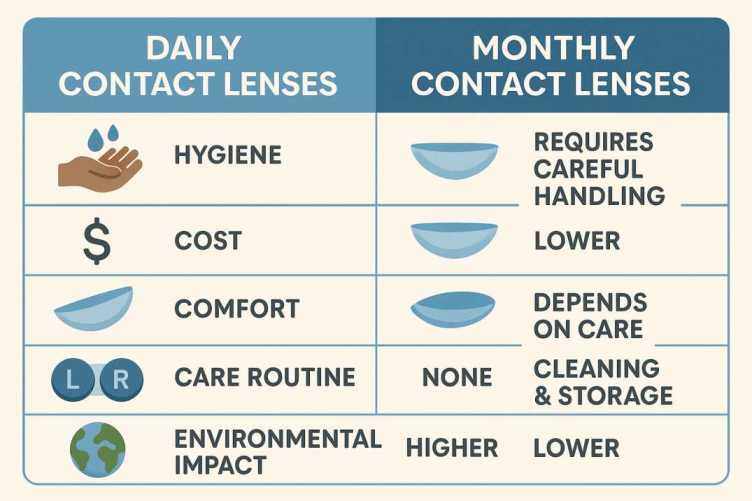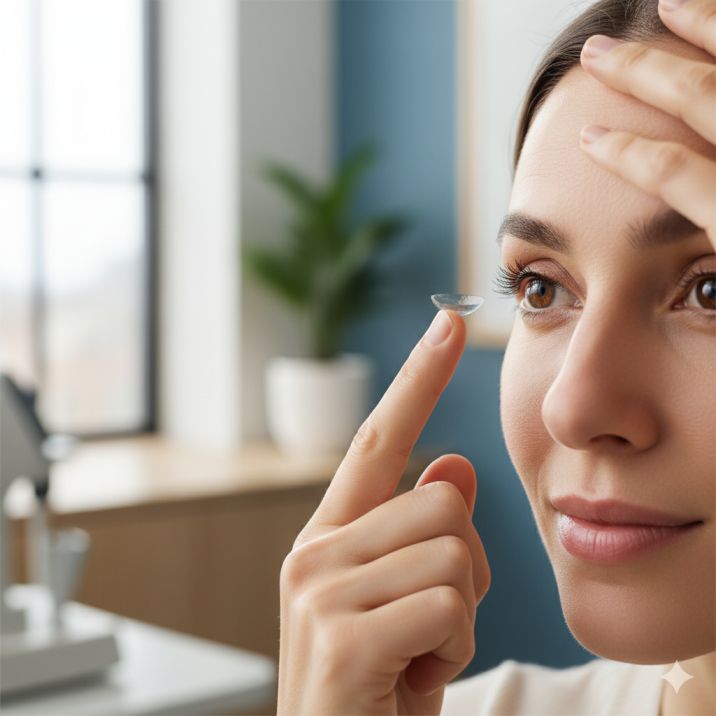Daily vs Monthly Contacts: Which One’s Better?
Bottom Line Up Front: Daily contacts offer maximum convenience and hygiene with single-use convenience, while monthly contacts provide cost-effective long-term wear with proper care. Your choice depends on lifestyle, budget, prescription complexity, and comfort preferences.
Choosing between daily contacts and long-term contacts represents one of the most important decisions for contact lens wearers. With approximately 45 million Americans wearing contact lenses, understanding the fundamental differences between these two options can significantly impact your eye health, comfort, and wallet.
This comprehensive guide examines every aspect of daily contacts versus long-term contacts, from comfort and cost considerations to eye health implications, helping you make an informed decision that aligns with your lifestyle and vision needs.
Understanding Daily Contacts: Single-Use Vision Correction
Daily contacts, also known as daily disposables, are single-use contact lenses designed for one day of wear before disposal. Each morning brings a fresh, sterile pair that you discard at bedtime, eliminating the need for cleaning solutions or storage cases.
At Cannon EyeCare, we often recommend daily contacts for patients with busy Seattle lifestyles who value convenience and maximum hygiene. Our comprehensive contact lens fittings ensure you get the perfect daily contacts for your unique vision needs and eye health.
How Daily Contacts Work
These ultra-thin contact lenses are manufactured with convenience in mind. Their thinner construction allows for excellent oxygen permeability while maintaining comfort throughout the day. The single-use design prevents protein deposits, bacteria, and allergens from accumulating on the lens surface.
Advantages of Daily Contacts
- Maximum Hygiene and Safety The most significant advantage of daily contacts lies in their hygienic design. With each new day bringing a fresh pair, there’s virtually no opportunity for bacterial buildup or contamination. This dramatically reduces your risk of contact lens-related eye infections.
- Ultimate Convenience: Daily lenses eliminate the hassle of nightly cleaning routines. Simply insert in the morning and dispose of at night – no solutions, cases, or maintenance required. This makes them ideal for busy professionals, frequent travelers, and anyone seeking maximum convenience.
- Superior Comfort for Sensitive Eyes The thin material and fresh-daily approach make dailies particularly suitable for people with dry eyes, allergies, or sensitive eyes. Without time for deposits to accumulate, comfort remains consistent throughout the wearing period.
- Perfect for Occasional Wear. If you don’t wear contacts daily, dailies provide excellent value. You only use what you need without worrying about monthly lenses expiring unused.
Disadvantages of Daily Contacts
- Higher Upfront Costs: Daily contacts typically cost more per lens, with monthly expenses ranging from $50-$75 for both eyes. However, this doesn’t include the hidden costs avoided with cleaning solutions and cases.
- Environmental Considerations The individual packaging creates more waste compared to monthly lenses, though this must be balanced against the plastic waste from solution bottles and cases used with monthly lenses.
- Fragility Concerns The thinner material makes daily lenses more prone to tearing during handling, particularly for first-time users or those with longer fingernails.
Understanding Long-Term Contacts: Monthly Vision Correction
Long-term contacts, also called monthly contacts, are reusable contact lenses designed for up to 30 days of wear with proper daily care and maintenance. These contact lenses require nightly removal, cleaning, disinfection, and storage in an appropriate solution.
Our patients at Cannon EyeCare’s University Village and Pike Place Market locations often choose long-term contacts for their cost-effectiveness and durability. With our thorough fitting process and ongoing care guidance, we ensure you maintain optimal eye health throughout your lens-wearing journey.
How Long-Term Contacts Work
Constructed from thicker, more durable materials than daily contacts, long-term contacts withstand repeated handling and cleaning. Most modern long-term contacts utilize silicone hydrogel technology, allowing up to five times more oxygen to reach the cornea compared to traditional hydrogel materials.
Advantages of Monthly Contacts
- Cost-Effective Long-Term Solution Monthly contacts offer significant savings for regular wearers, typically costing $20-$65 monthly for both eyes. The per-lens cost is substantially lower than dailies, making them budget-friendly for daily wear.
- Enhanced Durability The thicker construction makes monthly lenses more resistant to tearing and easier to handle. This durability proves especially beneficial for people who frequently insert and remove their lenses.
- Advanced Material Technology Many monthly lenses feature cutting-edge silicone hydrogel materials that provide superior oxygen transmission, moisture retention, and deposit resistance compared to older lens technologies.
- Reduced Environmental Impact With fewer individual packages and less frequent disposal, monthly lenses generate less packaging waste than dailies, appealing to environmentally conscious users.
Disadvantages of Monthly Contacts
- Maintenance Requirements: Monthly lenses demand consistent nightly care, including cleaning, disinfecting, and proper storage. This routine requires time, attention, and additional supplies.
- Infection Risk Factor: Extended wear increases opportunities for bacterial contamination, protein buildup, and deposits that can lead to eye infections if proper care isn’t maintained consistently.
- Comfort Degradation Even with excellent care, lens comfort may decrease as the month progresses due to subtle deposit accumulation and material changes.
Comprehensive Comparison: Daily Contacts vs Long-Term Contacts
Comfort and Eye Health
- Daily Contacts: Consistently high comfort levels due to fresh lens surfaces and no deposit buildup. Ideal for people with allergies, dry eyes, or sensitivity to cleaning solutions. At Cannon EyeCare, we find that many of our Seattle patients with dry eye conditions experience significant relief when switching to daily contacts.
- Long-Term Contacts: Generally comfortable but may experience slight comfort reduction over the 30 days. Advanced silicone hydrogel materials help maintain comfort longer.
Recent clinical studies show that both daily and long-term contacts made with silicone hydrogel materials provide excellent comfort, with daily contacts having a slight edge due to their fresh-daily nature.
Cost Analysis
Daily Contacts Cost Breakdown:
- Monthly cost: $50-$75 (both eyes)
- Annual cost: $600-$1,200
- Additional supplies: None required
Monthly Contacts Cost Breakdown:
- Monthly cost: $20-$65 (both eyes)
- Annual cost: $240-$780
- Additional supplies: $10-$20 monthly for solutions and cases
Winner: Long-term contacts for full-time wear; daily contacts for occasional use (3-4 days per week or less).
Convenience Factor
Daily contacts excel in convenience with no maintenance requirements, making them perfect for:
- Busy professionals with demanding schedules
- Frequent travelers avoid the solution transport
- People who forget or dislike cleaning routines
- Occasional lens wearers
Long-term contacts require dedicated maintenance but offer:
- Predictable replacement schedules
- No daily inventory management
- Backup contact lenses for emergencies
Prescription Availability and Vision Correction
- Daily Contacts: Available in most common prescriptions, including spherical, toric (astigmatism), and multifocal options. However, complex prescriptions may have limited choices in daily disposable contact lenses.
- Long-Term Contacts: Offer the widest range of prescription options, including specialized designs for high prescriptions, complex astigmatism, and unique fitting requirements. This is particularly important for patients we see at Cannon EyeCare who have challenging prescriptions that require precise customization.
Eye Health and Safety Considerations
Infection Risk Comparison
Research from the CDC indicates that contact lens-related eye infections affect approximately 2-5 people per 10,000 daily wear users annually, with significant variations between lens types and care practices.
Daily Contacts: Lower infection risk due to:
- Fresh, sterile surface daily
- No cleaning solution exposure
- Eliminated storage contamination
- Reduced handling opportunities for contamination
Long-Term Contacts: Slightly higher infection risk factors include:
- Extended wear allows bacterial growth
- Cleaning solution sensitivities
- Storage case contamination
- Improper care routine compliance
Material Science and Oxygen Transmission
Modern contact lenses utilize advanced materials designed for optimal eye health:
Silicone Hydrogel Technology: Both daily and monthly lenses now commonly feature silicone hydrogel materials, providing:
- Up to 5x more oxygen transmission than traditional hydrogels
- Improved moisture retention
- Better deposit resistance
- Enhanced all-day comfort
Daily Contacts Materials: Typically thinner with high water content, optimized for single-day comfort and easy disposal.
Long-Term Contact Materials: Designed for durability and deposit resistance while maintaining excellent oxygen permeability throughout the 30 days.
Making Your Decision: Which Type Suits Your Lifestyle?
Choose Daily Contacts If You:
- Value convenience above all: No cleaning routines or maintenance requirements
- Have sensitive eyes or allergies: Fresh lens surface eliminates allergen buildup
- Travel frequently: No solutions or cases to transport
- Wear contacts occasionally: Pay only for what you use
- Have a busy, unpredictable schedule: Maximum flexibility with no care requirements
- Are prone to losing or damaging lenses: Lower individual replacement cost
Choose Long-Term Contacts If You:
- Wear contacts daily: Better long-term value for consistent wear
- Have complex prescriptions: Wider availability of specialized designs
- Are comfortable with routines: Don’t mind nightly cleaning and care
- Prioritize environmental impact: Less packaging waste per lens
- Have steady hands: Can handle more durable lenses easily
- Want backup options: Keep spare lenses for emergencies
Professional Consultation Essential
Regardless of your preference, professional fitting and consultation remain crucial. At Cannon EyeCare, our experienced optometrists provide comprehensive contact lens evaluations that assess:
- Your specific prescription requirements and visual demands
- Eye health status and tear film quality for optimal lens selection
- Lifestyle factors and wearing patterns unique to Seattle living
- Any underlying conditions affecting lens choice
- Ongoing care and follow-up to ensure lasting comfort and eye health
Recent Scientific Evidence
Study 1: International Contact Lens Prescribing Trends (2024)
A comprehensive analysis of global prescribing patterns from 2019-2023 revealed that daily disposable lenses now account for 47% of all soft lens fittings, while monthly lenses represent 42%. This represents a significant shift toward dailies, reflecting growing consumer preference for convenience and hygiene.
Study 2: Comparative Comfort Analysis (2024)
Clinical research comparing daily versus monthly lens comfort over two months found no significant difference in average comfort levels between wearing modalities. However, daily lenses showed more consistent comfort throughout the wear period due to fresh lens surfaces daily.
Study 3: Silicone Hydrogel Market Penetration (2024)
Recent data shows silicone hydrogel materials now comprise 73% of all daily wear lens fittings, significantly improving oxygen transmission and comfort for both daily and monthly lens wearers. This technology advancement has made both lens types safer and more comfortable than ever.
Cost-Benefit Analysis by Usage Pattern
Heavy Users (Daily Wear)
- Monthly contacts: $240-$780 annually plus supplies = $350-$1,020 total
- Daily contacts: $600-$1,200 annually, no additional supplies needed
- Recommendation: Monthly contacts offer better value
Moderate Users (4-5 days/week)
- Monthly contacts: Same annual cost regardless of frequency
- Daily contacts: $430-$860 annually (proportional usage)
- Recommendation: Costs become comparable; choose based on convenience preference
Light Users (1-3 days/week)
- Monthly contacts: Full cost even with minimal use
- Daily contacts: $180-$520 annually (proportional usage)
- Recommendation: Daily contacts provide superior value
Environmental Impact Considerations
Daily Contacts Environmental Profile
- Packaging waste: Higher due to individual lens packages
- Manufacturing emissions: Increased due to more frequent production
- Disposal impact: More lenses entering the waste stream
- Offsetting factors: No plastic solution bottles or cases
Monthly Contacts Environmental Profile
- Packaging waste: Lower due to bulk packaging
- Solution bottles and cases: Additional plastic waste from care products
- Manufacturing efficiency: Fewer lenses needed per year
- Transportation: Lower shipping frequency requirements
Sustainable Practices
Regardless of lens choice, consider:
- Participating in contact lens recycling programs
- Proper disposal (never flush lenses)
- Choosing brands with sustainable packaging initiatives
- Using refillable solution systems when available
Tips for Optimal Contact Lens Experience
For Daily Contact Users:
- Store backups properly: Keep spare lenses in cool, dry locations
- Handle with clean hands: Always wash your hands before lens insertion
- Don’t extend wear: Never attempt to reuse daily lenses
- Carry backup glasses: Be prepared for lens damage or loss
- Monitor inventory: Ensure adequate supply before traveling
For Long-Term Contacts Users:
- Establish a consistent routine: Clean and store lenses same time nightly
- Replace cases regularly: New case every 3 months minimum
- Use fresh solution: Never reuse or “top off” storage solution
- Mark calendar: Track lens replacement dates
- Have backup pairs: Keep spare long-term contacts for emergencies
When to Consult Your Eye Care Provider
Schedule a professional evaluation if you experience:
- Persistent discomfort or irritation
- Recurring eye infections
- Vision changes or fluctuations
- Allergic reactions or sensitivity
- Desire to switch lens types
- Questions about proper care techniques
Schedule Your Contact Lens Consultation in Seattle
Ready to discover whether daily contacts or long-term contacts are right for your vision needs? At Cannon EyeCare, our experienced optometrists provide comprehensive contact lens evaluations tailored to your unique lifestyle and eye health requirements.
Contact Cannon EyeCare today:
- University Village Location: Convenient parking and modern facilities
- Pike Place Market Location: Downtown accessibility for busy professionals
- Comprehensive Contact Lens Fittings: Personalized recommendations based on your vision needs
- Ongoing Support: Follow-up care to ensure optimal comfort and eye health
Whether you’re new to contact lenses or considering switching between daily contacts and long-term contacts, our team provides the expertise and personalized care that makes the difference in your vision correction journey.
Future Trends in Contact Lens Technology
The contact lens industry continues evolving with innovations, including:
- Smart contact lenses: Glucose monitoring and augmented reality capabilities are gaining 22% interest among new buyers
- Extended wear improvements: Safer overnight wear options with advanced silicone hydrogel materials
- Sustainable materials: Bio-degradable and eco-friendly lens options addressing environmental concerns
- Customized designs: Personalized lenses based on individual eye topography and specific visual needs
- Drug-eluting lenses: Therapeutic lenses delivering medications for conditions like glaucoma and dry eye
Resources and Citations
The information in this article is supported by current research and authoritative sources in eye care and contact lens science:
Key Research Studies:
-
International Contact Lens Prescribing Trends (2024) – Morgan, P.B., et al. “International trends in daily disposable contact lens prescribing (2000–2023): An update.” Contact Lens and Anterior Eye, 2024. This comprehensive global survey tracks prescribing patterns, showing that daily disposables now account for 47% of all soft lens fittings.
-
Contact Lens Market Analysis (2025) – Vision Center Statistical Review. “Contact Lens Usage: Statistics and Trends.” This extensive market analysis provides current data on the 45 million Americans wearing contact lenses and infection risk statistics.
-
CDC Contact Lens Safety Guidelines (2025) – Centers for Disease Control and Prevention. “About Contact Lenses | Healthy Contact Lens Wear and Care.” Official CDC guidance on contact lens safety, hygiene practices, and infection prevention strategies.
Additional Authoritative Sources:
- American Academy of Ophthalmology contact lens safety recommendations
- International contact lens prescribing survey data (2019-2024)
- Clinical studies on silicone hydrogel material advancement and comfort comparisons
- FDA contact lens classification and safety guidelines
- Multiple industry pricing surveys and market research reports (2024-2025)
Note: All statistics and recommendations in this article reflect the most current available data as of 2025 and should be discussed with your eye care professional for personalized advice.
Conclusion: Your Path to Clear Vision
The choice between daily contacts and long-term contacts ultimately depends on your unique combination of lifestyle factors, budget considerations, and personal preferences. Daily contacts excel in convenience and hygiene, making them ideal for busy professionals, sensitive eyes, and occasional wearers. Long-term contacts provide cost-effective solutions for regular users comfortable with maintenance routines.
Remember that this decision isn’t permanent – many successful contact lens wearers switch between types based on changing circumstances, keeping both options available for different situations.
Ready to find your perfect contact lens match?
Schedule a personalized contact lens consultation at Cannon EyeCare today. Whether you prefer daily convenience or monthly value, our expert optometrists will guide you toward the best choice for your lifestyle, vision, and eye health.
Book your appointment now and see the difference!
FAQs
-
Daily contacts are used once and thrown away, while monthlies are worn for 30 days with nightly cleaning and storage.




